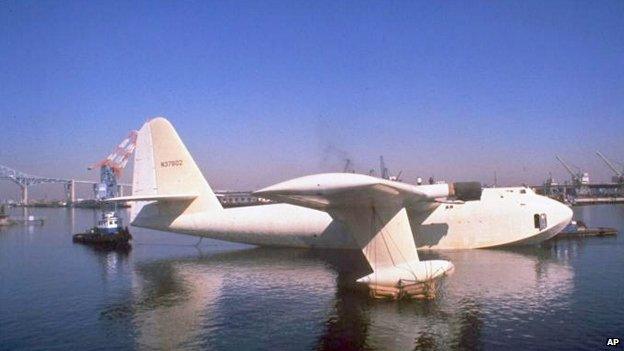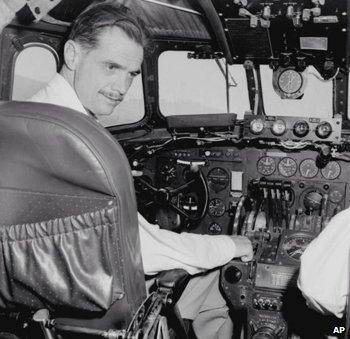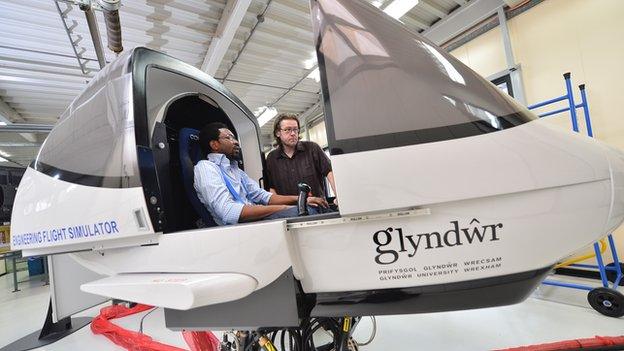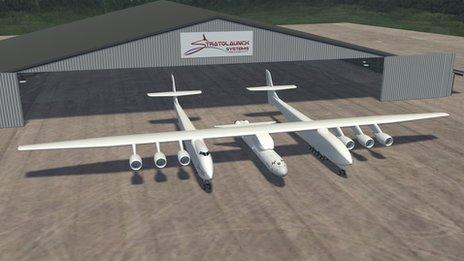Howard Hughes's Spruce Goose could fly, Glyndwr University flight sim shows
- Published

The Spruce Goose made only one short test flight, with Howard Hughes at the controls
A billionaire tycoon was right to say his plane - the heaviest ever built - could have flown, a university team has claimed using a flight simulator.
In 1947 Howard Hughes's H-4 Hercules was the largest, heaviest and most expensive plane ever built.
Yet aside from a one-mile test flight at 70ft (20m), the Spruce Goose - as it was nicknamed by critics - never flew.
A team at Wrexham's Glyndwr University says they have proved Hughes was right to insist it could have flown.

Howard Hughes always said his seaplane would have flown
In 1942 billionaire aviator, engineer, philanthropist and entrepreneur Howard Hughes won the contract to design a plane for the United States Air Force which could fly troops across the Atlantic, thus avoiding Nazi U-boats.
It had to be able to carry 750 troops or one Sherman tank up to 5,000 miles and at a cruising speed above 250 mph at up to 21,000ft (6,400m)
An additional challenge was to make the plane's body out of wood in order to conserve stocks of metal, hence its nickname of the Spruce Goose.
Shortages of materials and in-fighting with business partner Henry Kaiser meant that the only prototype ever built was not completed until 1947, two years after the war ended.
Hughes was summoned to the War Investigations Committee to explain the $22m cost.
With the plane's wingspan at 320ft (97m) and weighing-in at over 400,000lbs (180 tonnes) when loaded, many of the congressmen doubted that the Spruce Goose would ever have been able to fly at all.
'Holy grail'
Glyndwr University decided to pursue an answer to that question using its £200,000 Merlin flight simulator.
Flight simulator technician Nick Burdon said after calibrating the machine by feeding in the characteristics of everyday aircraft, the university team decided they needed more of a challenge.
He said: "For any fan of aviation the answer to the Spruce Goose mystery is the holy grail, so it seemed the ideal quest to set ourselves.
"There's a big aeronautical difference between a test flight at 70ft and cruising at 21,000ft, so the fact the Spruce Goose flew once means relatively little.

The Merlin flight simulator found the Spruce Goose was a flyer
"At such low altitude it would have been subject to ground effect, meaning that the closer to the ground it was, the greater the lift and the less the drag would have been on the wings.
"There's more finessing to be done to our model, such as the drag effect of the individual components and the fact that it was made almost entirely of wood, but the early indications are that it was a perfectly sound design.
"It wouldn't have been an easy plane to fly, because if you don't keep the wings entirely level then it has a tendency to go into a spiral which could have potentially ripped off the wings.
"But in the right hands, I believe it could do everything Howard Hughes maintained it could."
Yet Mr Burdon says righting historical wrongs is not the only purpose of the exercise.
He said: "Now we know we can push the boundaries of the modelling software, it will help Glyndwr's aeronautical engineering students come up with the next generation of aircraft design.
"Who knows, possibly something even as radical as the Spruce Goose?"
Away from aviation, Hughes became famous for dating Hollywood stars including Bette Davis, Katharine Hepburn and Ginger Rogers, as well as financing and directing movies.
His life-long battle against obsessive compulsive disorder (OCD) was portrayed by Leonardo DiCaprio in Martin Scorsese's 2004 film The Aviator.
Meanwhile the Spruce Goose itself survives in preservation at the Evergreen Aviation Museum in Oregon, USA.
- Published14 December 2011
